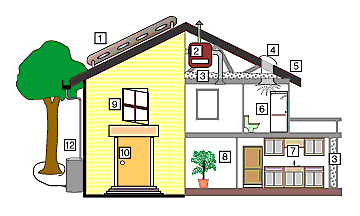![]()
![]()
![]()
![]()
![]()
![]()
![]()
Healthier, more livable spaces can be created by improving the home and work environments.
by Lynn M. Froeschle, AlA, copyright 1996
![]() etter building environments offer healthier, more livable
spaces that save resources and energy and are easy on the environment. The
principals of sustainable architecture emphasize improved indoor air quality,
using environmentally friendly building products, recycling, water conservation
and ecological construction methods. Energy savings can also be attained
by incorporating energy-efficient systems and environmental design features
into new or remodeled buildings. Proper resource management can minimize
the effect of the built environment on the natural environment.
etter building environments offer healthier, more livable
spaces that save resources and energy and are easy on the environment. The
principals of sustainable architecture emphasize improved indoor air quality,
using environmentally friendly building products, recycling, water conservation
and ecological construction methods. Energy savings can also be attained
by incorporating energy-efficient systems and environmental design features
into new or remodeled buildings. Proper resource management can minimize
the effect of the built environment on the natural environment.
The following are 20 simple procedures that
can be applied to make your home or office a more environmentally friendly
place to live and work. By incorporating these environmental features into
buildings, we can improve both the built and natural environments, and improve
our overall quality of life. By acting locally, we contribute to improving
the world environment through sustainable development.
![]()
The author is the principal of Lynn Froeschle,
AlA, Architects which specializes in sustainable architecture, environmental
design, and ecological construction methods. Ms. Froeschle has also received
a number of environmental design awards and has authored several published
articles on sustainable architecture. For further information on sustainable
and environmentally friendly architecture please contact Lynn Froeschle,
AlA at (619)571-2858.
In the next few issues, we'll be looking at
some of these 20 steps plus a few others in more detail to help
you achieve a more sustainable home or office environment.

 Avoid using building materials with chemical emissions such as
formaldehyde, solvents, and volatile organic compounds (VOC's). These compounds
can be found in particle board, paints, vinyl floor and wall coverings,
certain types of carpet, and even insulation. Building material chemical
emissions contribute to causing Sick Building Syndrome and can make you
sick.
Avoid using building materials with chemical emissions such as
formaldehyde, solvents, and volatile organic compounds (VOC's). These compounds
can be found in particle board, paints, vinyl floor and wall coverings,
certain types of carpet, and even insulation. Building material chemical
emissions contribute to causing Sick Building Syndrome and can make you
sick.
Do use building materials with minimal chemical emissions such as ceramic tile, linoleum, formaldehyde-free particle boards, low-VOC paints and sealers, low-VOC adhesives, and non-toxic cleaners. Obtain Material Safety Data Sheets (MSDS) and available test data from manufacturers of all building related materials to verify what each product contains prior to using it.
 Use products with recycled content. Incorporate building products
with recycled content into your next building remodel. Less energy and resources
are expended in manufacturing products with recycled content thus helping
the natural environment.
Use products with recycled content. Incorporate building products
with recycled content into your next building remodel. Less energy and resources
are expended in manufacturing products with recycled content thus helping
the natural environment.
Reduce, Reuse, Recycle. Try to reuse and refurbish existing building components before you replace them with new materials. Keep in mind that most construction debris is recyclable. Avoid landfill tipping fees by contacting the City of San Diego Environmental Services or San Diego County for a list of construction demolition and yard waste recyclers.
 Minimize use of carpet. Chemically treated carpets, adhesives,
and backings can emit numerous chemicals. Also carpets can contribute to
indoor air pollution due to collection of dust and other pollutants in the
carpet fibers. Where carpet is used, obtain test data prior to purchase
and avoid carpets with topical chemical treatments. Consider airing-out
the carpet prior to installation and use of a zeolite mineral wash to help
absorb odors. Use low-VOC adhesives for installation. Consistent maintenance
is also important.
Minimize use of carpet. Chemically treated carpets, adhesives,
and backings can emit numerous chemicals. Also carpets can contribute to
indoor air pollution due to collection of dust and other pollutants in the
carpet fibers. Where carpet is used, obtain test data prior to purchase
and avoid carpets with topical chemical treatments. Consider airing-out
the carpet prior to installation and use of a zeolite mineral wash to help
absorb odors. Use low-VOC adhesives for installation. Consistent maintenance
is also important.
![]() Use energy efficient lighting. Replace your energy consuming traditional
incandescent light bulbs with the super energy saving compact fluorescent
lights with SDG&E rebates. Plus, they last considerably longer saving
you money in the long run. These lights are available at many home improvement
outlets.
Use energy efficient lighting. Replace your energy consuming traditional
incandescent light bulbs with the super energy saving compact fluorescent
lights with SDG&E rebates. Plus, they last considerably longer saving
you money in the long run. These lights are available at many home improvement
outlets.